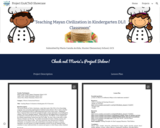
In this activity, students explore opportunities to share while learning about human differences and similarities.
- Subject:
- Social Studies
- Material Type:
- Activity/Lab
- Provider:
- Crayola
- Date Added:
- 06/14/2018

In this activity, students explore opportunities to share while learning about human differences and similarities.

Lesson one sets the foundation for the students to understand how their families are similar and different in respect to kinship, laws, and religion, as well as the music they enjoy, the clothing they wear, and the food they eat.

In this lesson, students explore the customs and traditions celebrated in their own homes, as well as interview invited guests to learn about other customs and traditions.

Lesson four expands on the idea of family similaritiesto include customs and traditions. Just as families celebrate customs and traditions in their home, community members celebrate customs and traditions in their neighborhood. These neighborhood celebrations often include a variety of events and activities such as parades, sport games, and festivals that include music, clothing, and food. These customs and traditions help define the community, and contribute to a spirit of belonging and togetherness.

In this lesson, students learn about what makes a celebration. They brainstorm celebrations they have experienced and classify them into categories. Students focus on national holidays and learn about two holidays celebrated in our national community: Veterans Day and Independence Day.

In this lesson, students utilize their understanding of local celebrations to create a proposal for a celebration based on their school community. The celebration will focus on what is important to the school. Students learn the decision making process and work in planning groups to determine key aspects of the celebration and write a letter explaining the proposal to an authority figure in the school, such as the school principal. Students use voting as a way to make a group decision.

In this lesson, students will learn about the Maori culture in the New Zealand area and play the Maori Stick Game. It will help them to understand how individuals are similar and different.

For this activity, students learn about different types of families and exhibit pride in their own unique family without judging other families. Students will also understand, appreciate and respect differences and similarities in their classroom and school.

In this lesson, students play a series of games to help them learn the names of classmates. They will also answer questions about themselves so that their classmates can learn more about them. Students can compare themselves to other classmates and identify similarities.

The activities in this lesson plan will help students understand the similarities and differences in families and identify attributes in themselves and others.

This video shows how an elementary classroom uses a Star Student of the week to foster a foundation for good citizenship, class community, and self-identity.

In this lesson, students make a movie / slide show presentation about the unique strengths, talents, and goals of class members.

Students utilize their understanding of local celebrations to create a proposal for a celebration based on their school community. The celebration will focus on what is important to the school. Students learn the decision making process and work in planning groups to determine key aspects of the celebration and write a letter explaining the proposal to an authority figure in the school, such as the school principal. Students use voting as a way to make a group decision.

Submitted by Maria Camila Archila, Hunter Elementary School, GCS

Students will create a paper face and a paper face book. The teacher will lead a discussion about faces and what they consist of. Students will graph class eye and hair colors to assist in noting their differences and similarities.

Students compare how they are the same and different from their classmates.

This activity helps promote diversity by uisng the book, The Crayon Box that Talked.